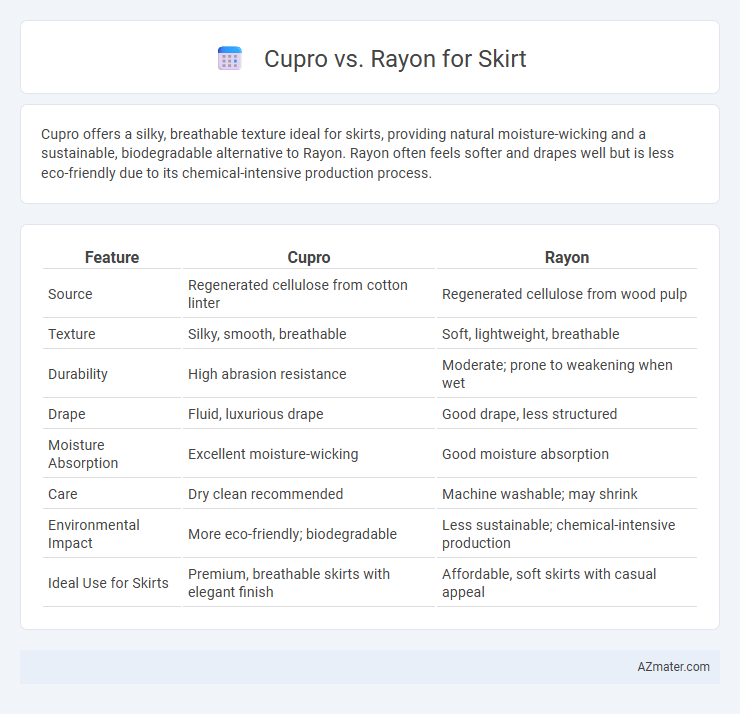Cupro offers a silky, breathable texture ideal for skirts, providing natural moisture-wicking and a sustainable, biodegradable alternative to Rayon. Rayon often feels softer and drapes well but is less eco-friendly due to its chemical-intensive production process.
Table of Comparison
| Feature | Cupro | Rayon |
|---|---|---|
| Source | Regenerated cellulose from cotton linter | Regenerated cellulose from wood pulp |
| Texture | Silky, smooth, breathable | Soft, lightweight, breathable |
| Durability | High abrasion resistance | Moderate; prone to weakening when wet |
| Drape | Fluid, luxurious drape | Good drape, less structured |
| Moisture Absorption | Excellent moisture-wicking | Good moisture absorption |
| Care | Dry clean recommended | Machine washable; may shrink |
| Environmental Impact | More eco-friendly; biodegradable | Less sustainable; chemical-intensive production |
| Ideal Use for Skirts | Premium, breathable skirts with elegant finish | Affordable, soft skirts with casual appeal |
Introduction to Cupro and Rayon Fabrics
Cupro is a regenerated cellulose fiber derived from cotton linter, known for its silky texture, breathability, and eco-friendly production process, making it a popular choice for skirts that require a luxurious drape and smooth finish. Rayon, also a semi-synthetic fiber made from wood pulp, offers excellent moisture absorption and softness but varies widely in quality depending on production methods, impacting durability and appearance in skirt fabrics. Both fibers provide comfortable, lightweight options for skirts, with Cupro typically favored for its sustainable credentials and high-end appeal, while Rayon offers versatility and affordability.
Understanding Cupro: Composition and Properties
Cupro, derived from regenerated cellulose fibers made from cotton linter, offers a luxurious feel similar to silk with excellent breathability and moisture-wicking properties. Its smooth texture and natural sheen make it an ideal fabric for skirts, providing a soft drape and comfort in warm weather. Unlike rayon, cupro is less prone to shrinkage and has better durability, retaining its shape and color over time.
What is Rayon? Origins and Characteristics
Rayon is a semi-synthetic fiber made from regenerated cellulose derived mainly from wood pulp, originally developed in the late 19th century as a silk alternative. Known for its versatility, rayon drapes well, offers a soft and smooth texture, and is highly breathable, making it popular in lightweight skirts. Its moisture-absorbing properties and capability to mimic natural fibers like cotton and silk contribute to its widespread use in fashion, especially for comfortable and stylish skirts.
Comparison of Texture and Feel
Cupro fabric offers a smooth, silky texture with a luxurious, cool-to-the-touch feel, making it ideal for skirts that require a soft drape and breathable comfort. Rayon, on the other hand, presents a slightly heavier, more absorbent texture with a matte finish, often feeling warmer against the skin and providing a flexible, fluid movement. Both fabrics enhance skirt wearability, but Cupro emphasizes elegance and softness, while Rayon prioritizes versatility and affordability in texture.
Durability: Cupro vs Rayon in Daily Wear
Cupro offers superior durability compared to rayon in daily wear due to its fiber strength and resistance to pilling and shrinking. Rayon tends to weaken with repeated washing and friction, making cupro a longer-lasting choice for skirts. The breathable and silky texture of cupro also maintains its structural integrity better over time, enhancing skirt longevity.
Breathability and Comfort for Skirt Designs
Cupro offers superior breathability due to its natural cellulose fibers derived from cotton linter, allowing excellent moisture absorption and air circulation in skirt designs. Rayon, while also breathable, tends to retain more moisture and can feel less comfortable in hot or humid conditions compared to cupro. Skirts made from cupro provide a softer feel and better temperature regulation, enhancing overall comfort during wear.
Sustainability and Eco-Friendliness
Cupro is a regenerated cellulose fiber derived from cotton linter, making it biodegradable and sustainable due to its production from cotton waste and water-efficient processes. Rayon, produced from wood pulp using chemical-intensive methods, often raises environmental concerns because of deforestation and harmful chemical use in manufacturing. Choosing Cupro over Rayon for skirts supports eco-friendly fashion by reducing resource consumption and minimizing toxic byproducts.
Care Instructions: Washing and Maintenance
Cupro skirts require gentle hand washing or delicate machine cycles with cold water to preserve fabric integrity and avoid shrinkage, while avoiding bleach and tumble drying. Rayon skirts also demand careful washing by hand or on a delicate cycle in cold water, with air drying recommended to prevent damage and maintain softness. Both fabrics benefit from ironing on low heat and storing in breathable garment bags to extend garment lifespan and maintain quality.
Price Point and Availability
Cupro fabric offers a mid-range price point, typically higher than rayon due to its eco-friendly production and limited manufacturing sources. Rayon skirts are generally more affordable and widely available, benefiting from mass production and diverse fabric suppliers. Availability of cupro is more restricted, often found in premium or sustainable fashion collections, whereas rayon is accessible across various price segments and retailers.
Which Fabric is Best for Skirts? Final Verdict
Cupro offers a silk-like feel with excellent breathability and a smooth drape, making it ideal for fitted or flowing skirts that require comfort and elegance. Rayon provides versatility and affordability with good moisture absorption, but it may lack Cupro's durability and resistance to wrinkles. For skirts prioritizing luxury, softness, and long-lasting wear, Cupro is the better fabric choice, while Rayon suits budget-conscious buyers seeking easy maintenance.

Infographic: Cupro vs Rayon for Skirt
 azmater.com
azmater.com